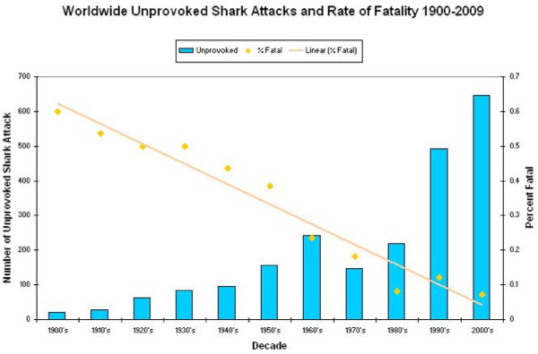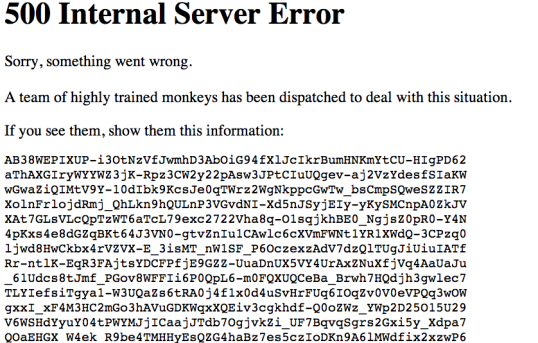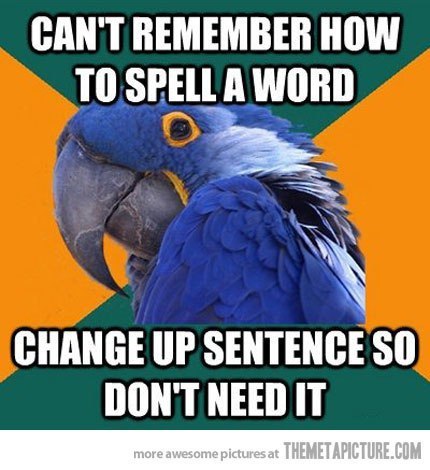Tyson Adams's Blog, page 75
February 10, 2014
Well played, internet, well played.
All I can say is, fly my pretties, fly.
Tagged: Funny, Humour, internet, Right What You No, Server error, Tyson Adams

February 8, 2014
Entertaining TV of 2013
With many of my favourite shows now back on air for 2014, except the ones that were cancelled, I thought it was a good time to recap what kept me entertained on the small screen in 2013.
Many people have noted the rise of decent TV, leaving behind the days of formulaic plots (e.g. CSI whatever), sit coms that lack the comedy (e.g. Two and A Half Men), dramas that lack plot (e.g. Lost), lame reality TV shows (e.g. Duck Dynasty), and the cancellation of a Joss Whedon show before it got a chance to be awesome (e.g. every show he’s ever made). This is at the same time as movies have failed to produce anything particularly memorable or interesting in quite some time.
I actually have a theory (by theory I mean hypothesis) about why there are fewer and fewer decent movies. It comes down to this little figure: Let’s leave aside the gross disparity between the highest paid actor vs. actress discussion, instead let’s focus on those paychecks. You stick just one of those stars in a movie, just one, and you are going to have a really expensive movie that is going to battle make its money back at the box office. Movie studios know this, so they spend up big on special effects, production values, promotion, etc, to lure people into the cinema. But in an effort to attract as large an audience as possible to make up for this huge spend, they make the movies as bland as possible in order to accommodate a wide audience from around the world. The reason that movie sucks isn’t because it is aimed at 12 year olds, its aimed at 12 year olds who probably don’t understand idioms due to being in a different country/culture.
Let’s leave aside the gross disparity between the highest paid actor vs. actress discussion, instead let’s focus on those paychecks. You stick just one of those stars in a movie, just one, and you are going to have a really expensive movie that is going to battle make its money back at the box office. Movie studios know this, so they spend up big on special effects, production values, promotion, etc, to lure people into the cinema. But in an effort to attract as large an audience as possible to make up for this huge spend, they make the movies as bland as possible in order to accommodate a wide audience from around the world. The reason that movie sucks isn’t because it is aimed at 12 year olds, its aimed at 12 year olds who probably don’t understand idioms due to being in a different country/culture.
And this is why we get a list of gems on the small screen, because the writers, directors, and quite a few actors, have realised that in order to tell good stories, they can’t spend huge dollars (unless it is on prime time crap).
Justified
Possibly my favourite show of the past few years. This is not only well written, the entire cast and crew seem to have this knack for creating great TV. Plus, last season featured Patton Oswalt.
Sherlock
I love this show for its wit, humour, modernising of the classic Sherlock Holmes stories, and the casting. Some have accused it of being smug, but I see that as central to Sherlock’s character, thus welcome in the show.
Luther
I read the prequel novel by series writer Neil Cross and it was every bit as good as the TV show. Idris Elba took a break from fighting monsters in giant robot suits in order to make another season of this fantastic crime drama.
Banshee
When I describe this show to friends, they always come away thinking that I’ve described a violent, b-grade, action movie with plenty of nudity. Just another throw back to the pulp novel trash that I also have occasion to read. Well, yes. The problem being? The best new show on TV in 2013, hands down!
Person of Interest
I really enjoyed the first season of Person of Interest. The second season was more of the same but brought more of the very interesting character portrayed by Amy Acker. Season 3 was off to a good start before the non-ratings break. Now that I’ve raised that point, why do we even have a non-ratings period any more? TV watching habits have changed, the networks better change with the times or lose out to the internet… oh wait, they are.
Continuum
I discovered this sci-fi gem by accident. One of the problems I’ve always had with time travel in books, TV and movies is that they don’t deal with the paradox very well. Even in Back to the Future it is almost played for a joke. This series is well written and actually has the paradox central to its story structure. It also helps that Rachel Nichols does a good job of holding the series together.
Revolution
Another post-apocalyptic story, ho-hum. This series has an interesting take on what would be society’s downfall and what would subsequently happen. There is a lot to like about this show, especially Billy Burke as a bad-ass. Although, after the first season, I didn’t see much point in having a second season and won’t be following it.
Arrow
This is one of the few mainstream shows I find watchable. It is pretty much down to the fact that they have some good fights, an interesting premise culled from the source material, and that the actors have done the hard yards physically for the show (especially Stephen Amell and Manu Bennett). Makes me want to build a salmon ladder in my backyard.
H+
Not often that a web series could attract a big name director like Bryan Singer (of the decent X-Men movies fame) to make a series of short scene sci-fi. I’d characterise the series as essentially 48 vignettes with overlapped characters and story, as most episodes can stand alone to some extent, despite being part of a larger narrative.
Archer
Quite simply, this show is the funniest thing on TV. In the proud tradition of cartoon comedies, it is able to do things that other TV shows and comedies can’t, due to financial, legal or ethical constraints. This series is also one of the few with DVD extras that you would actually want to watch. One of the best is when Archer has an accident and is transformed into a character much more like his voice actor, with ensuing gags around this.
Rake
This Aussie comedy-drama has been a consistently witty and interesting tale about a self-destructive Sydney barrister. Normally Aussie humour doesn’t translate well to other parts of the world, but Rake has been adapted for the USA, with Greg Kinnear replacing Richard Roxburgh.
Tried but lost interest:
Almost Human – promising sci-fi that didn’t really capture my attention
The Walking Dead – so sick of that fucking farm!
Marvel’s Agents of Shield – this should have been good, but was meh.
The Booth At The End – interesting premise but didn’t grab me.
The Following – I can honestly say that this series squandered such a great premise with derivative and clichéd story.
The Blacklist – this was interesting only because of James Spader. Needed more than that.
Vikings – interesting but too slow moving.
Hannibal – this was fantastic. I don’t know why I haven’t watched more, but I just haven’t.
What!?! You don’t watch….
The Game of Thrones – after watching the first season I had had enough. You only have to watch this far to see Sean Bean die, so game over.
Breaking Bad – I’ve dropped in and out on this series, watching episodes throughout. I’ve really enjoyed it, but not something I’ve made time to watch all of.
Arrested Development – yeah, I know. I should be a rabid fan.
The Killing – both the US and the Danish Forbrydelsen are slow boil crime shows that I’ve started watching and not continued. No particular reason for stopping, just haven’t gotten to the rest of the episodes yet.
Borgen – have heard great things, but just haven’t gotten to it yet.
Tagged: Almost Human, Archer, Arrested Development, Arrow, Banshee, Best of 2013, Borgen, Breaking Bad, Continuum, decent TV, Enjoy, Forbrydelsen, Game of Thrones, Greg Kinnear, h, Hannibal, Idris Elba, Joss Whedon, Justified, Luther, Marvel's Agents of Shield, Movies, opinion, Person of Interest, Rake, Reality TV, Revolution, Sherlock, Sherlock Holmes, The Blacklist, The Booth At The End, The Following, The Killing, The Walking Dead, TV, TV shows, Tyson Adams, Vikings

February 5, 2014
Nye vs. Ham: science vs. nonsense
There is a general rule in arguments: don’t argue with stupid people, they drag you down to their level and beat you with experience. That is pretty much the problem scientists and experts have when debating anti-science proponents – such as creationists, anti-vaccinators, anti-GM campaigners, climate change deniers, etc. Yet Bill Nye the Science Guy decided that, in the interest of science and education, he would debate a creationist.
The debate started with Bill Nye and Ken Ham stating a 5 minute opening piece. Then Ken went into his 50 minute argument, which is when my cushion really started to earn its keep protecting my desk from damage.
I really find it hard to fathom how anyone can be credulous of Ham’s statements. In his 50 minutes he used all sorts of logical fallacies, most notably his videos of “creationist scientists” as argument from authority. But it wasn’t this that really got the lump on my forehead rising, it was the use of “evidence” for his argument that simultaneously refuted the arguments. One example was the phylogenetic tree for dogs. Ham argued that the rise of Canis lupus familiaris from a wolf (yeah, just one, let’s just let that one go through to the keeper) was what you would see from biblical predictions of dogs speciating after the global flood 4,000 years ago. Just one problem. Teeny tiny. The figure showed dogs evolving from a group of wolf ancestors over the course of 14-15,000 years.
He didn’t just do this once, he did it repeatedly. Another example arose when he was talking up one of his creationist pals who helped design a satellite (or something, didn’t really care because it was irrelevant). He used the example of how scientists had been debating how old the universe was: they couldn’t agree on the age. The part he left out about that particular debate was that the age of the universe was somewhere around about 13.8 billion years old (+ 37 million years), and they had a bunch of data they were trying to make sure they had the errors accounted for. The debate was about the difference in the confidence range (or error margin) between the Planck satellite measures and the Wilkinson Microwave Anisotropy Probe measures. The error margin is 6,000 times greater than the age of the Earth that Ham claims. The Earth’s age is still 2 million times older than Ham’s claim, yet he uses this example as if to give credence to his claims.
Now Nye did his best in his 50 minutes to show that Ham’s claims were flawed, but also how evidence and scientific observation and prediction work. Others have claimed, and I agree to an extent, that Nye’s mistake was to try and cover too much ground. If he was talking to a receptive audience he would have destroyed Ham and had the crowd eating out of his hand. But at a creationist museum, with a bunch of science deniers, it would come across as too much information and too confusing. Although Nye’s last couple of minutes pretty much killed the entire debate, with trees, rocks, size of the universe, distance from stars but limits of how fast the light can travel, all showing that the Earth and Universe are much much older.
The first rebuttal saw Ham carrying on about “you weren’t there so you don’t know.” Brian Dunning had a great take on this particular argument:
Brian Dunning
There is a rumor that Bill Nye @TheScienceGuy debated evolution with Ken Ham. Not true. It did not happen, because you weren’t there.
In this first rebuttal, Ham again used evidence that rebutted his own claims, especially when talking about radio-carbon dating. Showing that measurements have error margins, or can be somewhat imprecise, doesn’t negate the fact that the measurements are still many orders of magnitude outside of the age of the Earth claimed by Ham. Then he moved onto saying that the bible is right, everything else is wrong (let’s just ignore that the bible isn’t even consistent with itself, let alone the fact that it is a translation of a translation, thus literal interpretation isn’t supported by biblical scholars).
Nye then rebutted Ham’s statements. His classic put down was for the claim that every animal and humans were vegetarian until they got of the ark: lion’s teeth aren’t really made for broccoli.* Ba-zing!
Next Ham tried to point out that creationism isn’t his model (then he blames secularists for scientists). This is true, there are other nutters who came up with this crap. But Ham tried to pretend that “scientists” came up with the various creation models (NB: just because a scientist said something, doesn’t make it science or scientific). Then he talks about species and kinds and how Nye was confusing what a kind was. Easy to do when the idea of a kind is bullshit and unsupported by any actual science.
Nye then tore apart the claims about the rise of species from kinds using the basic math involved. He also called bullshit on the ship building skills of ancient desert people. The main point in this rebuttal was that Ham hadn’t addressed Nye’s point adequately, and that Ham’s claims aren’t supported by the majority of religious people, let alone scientists.
My desk and forehead had had enough by this stage, so I didn’t watch the Q&A section, but it can be viewed here.
The point I wanted to make from this was that Ham had a huge advantage in this discussion. I’m not talking about the home team venue, nor the credulous crowd, I’m talking about the lack of need for evidence. All Ham had to do, and pretty much what he did, was seed doubt in science and then declare “creationism wins” (which might as well be “God did it”). This is the problem with any debate with anti-science: the scientists have to prove their case with evidence and logical reasoning; the anti-science side only has to sow some doubt. And that doubt can vary between legitimate claims through to flat out lies, it doesn’t matter. So Nye shouldn’t have taken the debate.
But Nye was right to take the debate.
Hang-on. Have you hit your head against your desk a few too many times during that debate?
No. Bill Nye is a well known and respected science communicator. He went into the belly of the beast to stand in the echo chamber and sow some doubt (how’s that for a metaphor-fest?). As he stated himself, Nye knows that America (and the world, but let’s allow him his patriotism) needs science and innovation for the future of society. Creationism and other anti-science nonsense undermine this. If no-one challenges the group-think and echo chamber of the creationists (et al.) then they will continue to be mislead and misinformed by people like Ken Ham. You can’t have someone reject evolution yet rely on germ theory for modern medicine. You can’t have someone reject radio-carbon dating yet use medical imaging. That is incompatible, that is a rejection of reality, and it leads to stupid stuff happening that curbs development of new technologies and advancements to society.
Other opinions on who won:
Shane proposes that Nye needed to pick a couple of points to hammer home. This feeds into science communication research that shows you can get distracted from the main narrative with too many points.
Christian Nation have Bill Nye winning the debate 92% to 8%.
* Okay, not the best point to make, as teeth aren’t definitive of diet, but if the comment is viewed as being representative of animal physiology overall, then it is a very valid putdown of the vegetarian claims.
Tagged: Anthropogenic global warming, anti-GM, anti-GMO, anti-science, Anti-Vaccination, Anti-Vaxxers, Asshattery, Bible, Bill Nye, Bill Nye the Science Guy, Climate change denial, Creationism, Creationist, God, Ken Ham, Nye vs Ham, opinion, Reality, Science, Truth vs Lies, Tyson Adams

February 4, 2014
February 2, 2014
Mythtaken: Shark Attack Deaths
Ever since Spielberg made us scared of seeing any more Indiana Jones films, people have felt better about blaming him for the hysteria around sharks.
Recently in my home state of Western Australia there has been a decision made to cull sharks because some people have been killed by them. Clearly we should blame sharks for just wanting a hug and not humans for dressing up like shark food. This is a stupid decision and I’m about to outline why we can’t even tell if there have been more shark deaths, let alone whether a cull would actually work, let alone whether you’d know if the cull does anything. It all comes down to statistics. Well, that and media beat-ups to sell advertising space.
You’d honestly think that there had been a change in the number of people dying in Australia from shark attacks in order to justify a shark cull. Well, the official stats show there hasn’t been an increase in deaths from shark attacks. In fact the deaths are so low the noise around the long term average of 1.38 deaths per annum (2000-2012), that any increase or decrease in deaths are impossible to assign any significance to (see chart below). Three deaths in a year (2000): could be an anomaly. Zero deaths the year after (2001): likely to be regression to the mean. Number of deaths from the most ferocious animal on the planet: bees; 10 per year.

Graph of Aussie shark attacks 2000-2012. Blue is total encounters, yellow is non-fatal, red is fatal. Trend lines for total and fatal.
What you do see in the data is a slight increase in the number of attacks. If you look at the number of attacks and fatalities since 1900, there has been a general increase in the number of shark attacks, but a decrease in the fatalities from shark attacks. It’s almost as though there are more people in the world and more of them bobbing up and down in the ocean in seal costumes, possibly on a tasty cracker.

International Shark Attack File data, Florida Museum of Natural History
Now this is interesting for the world and Australia, as it appears that despite our best efforts as humans, sharks aren’t taken revenge for the 100 million of them we kill each year. But this is about a shark cull in Western Australia: what’s happening there? Well, these tables say it all really:
State
# Cases
Fatal
Injured
Uninjured
Last Fatality
NSW
243
68 (27.9%)
120
55
2013 Coffs Harbour
QLD
251
82 (32.7%)
151
18
2011 Fantome Island
WA
92
20 (21.7%)
57
15
2013 Gracetown
SA
48
18 (37.5%)
23
7
2011 Coffin Bay
VIC
45
9 (20%)
27
9
1987 Mornington Peninsula
TAS
15
3 (20%)
8
4
1993 Tenth Is, Georgetown
NT
10
2 (Duh)
6
2
1938 Bathurst Island
Total
704
202 (28.7%)
392
110
(Revised 28/1/2014)
Provoked Cases Since 1832:
# Cases
Fatal
Injured
Uninjured
Total
190
15
129
46
Western Australia accounts for ~13% of shark attack deaths. When we look at 2012 data we see that WA is having a greater proportion of the Australian attacks and accounts for all the fatalities in Australia. The terms “bigger population”, “longer coastline”, “more cashed up bogans“ come to mind.
Australian Shark Encounter Statistics for 2012:
State
Cases Recorded
Fatal
Injured
Uninjured
NSW
5
0
3
2
QLD
1
0
1
0
SA
1
0
1
0
WA
5
2
2
1
VIC
1
0
1
0
TAS
1
0
1
0
NT
0
0
0
0
TOTAL – Unprovoked
14
2
9
3
TOTAL – Provoked
8
0
5
3
All Cases
22
2
14
6
So there is no actual proof that there are any more deaths occurring from shark attacks, definitely no trend toward more deaths, but a significant increase in the number of media reports on those deaths (citation needed). Even on a state by state basis there isn’t any death trend. But there is a trend towards more shark incidents. What we are actually seeing is an increase in the number of people dressing up like seals/shark food (scuba divers and surfers).
Circumstances affecting shark / human interactions:
The number of shark-human interactions occurring in a given year correlates with human population increases and the amount of time humans spend in the shark’s environment. As Australia’s population continues to increase and interest in aquatic recreation rises, it would realistically be expected that there will be an increase in the number of shark encounters.
Let’s put that in perspective, Australia has a 1 in 3,362 chance of drowning at the beach and a 1 in 292,525 chance of being killed by a shark in one’s entire lifetime. In Australia there are 1.38 deaths per year from sharks, 121 deaths per year from drowning at the beach, and 1,193 deaths per year from driving. We’re more likely to die from all the stupid shit we do, than from sharks. So why have a shark cull?
There is no real reason to have a shark cull. We already kill 100 million of the things annually anyway. What we actually need to do is look at where the sharks are looking for food, has their food moved, if so due to what, and are we seeing less shark food available such that sharks are looking for alternate foods. The shark cull with drum lines and nets is actually likely to kill off dolphins, turtles, rays, and endangered shark species, which is why fisheries researchers don’t support the cull. For more, read these articles:
https://theconversation.com/wa-shark-frenzy-how-to-stop-a-runaway-train-22669
http://www.nature.com/news/australian-shark-cull-plan-draws-scientists-ire-1.14373
https://theconversation.com/western-australias-shark-culls-lack-bite-and-science-21371
https://theconversation.com/cull-or-be-killed-is-this-really-the-solution-to-stop-shark-attacks-3961
http://tysonadams.com/2013/10/16/mythtaken-shark-attacks/
http://tysonadams.com/2011/10/24/shark-attack/
Tagged: Australia, Deaths, Mythtaken, Right What You No, Science, Shark attack, Shark attacks, Shark deaths, Shark fatalities, Shark fatality, Shark injuries, Shark statistics, Sharks, Statistics, Tyson Adams, Western Australia

January 28, 2014
4 Reasons to Make Your Email Public
I read a blog post recently that suggested it is a good idea to make your email address publicly available on your webpage (and elsewhere). This is a great idea. The blog author listed 4 reasons, so I’ll list another 4.
Because everyone needs an extra couple of inches on their penis.
Even if you are a woman. Maybe especially if you are a woman.
How will SEO marketers contact you without your email?
Except via the comments and domain registry information.
Nigerian Royalty could be trying to contact you.
I hear they need to give away money to people they don’t know.

From See Mike Draw. Become a fan NOW!
Because there is no such thing as social media and direct messaging.
I mean, who even has a Twitter, Facebook, LinkedIn, Tumblr, Google+, etc, account these days? And there are definitely no features that allow you to privately contact the person via those mediums.
Tagged: blog post, Email, Facebook, Google, Humor, Humour, Nigerian Royalty, Penis enlargement, publicly available, Right What You No, Satire, See Mike Draw, SEO, Social media, Spam, Twitter, Tyson Adams

January 26, 2014
Can’t we all just get along: DTB vs E-book

The big take home from this infographic is that readers are more interested in reading, not on the format it comes in. I also found it interesting that people read slower on an e-reader (which I’d guess is because the screen is smaller and requires more ‘page turns’ which breaks reading flow) yet those using e-readers read an average of 9 more books per year (24 vs 15).
In summary: reading is good, go and enjoy a good book.
Tagged: Book, Co-exist, DTB, E-book, E-books, e-reader, E-readers, Infographic, Library, Printed books, Reading, Right What You No, Statistics, Stats, Tyson Adams

January 24, 2014
Will individuals respond differently to homeopathic remedies prepared with unboiled vs. boiled water?
I recently watched a debate between Ben Goldacre and Peter Fischer on homeopathy. During the course of the debate, an audience member asked, “If water has a memory, how come you’re not sick every time you drink water out of the tap?.
A homeopathic practitioner answered (paraphrased) that boiling the water resets the memory and that homeopathic remedies are only effective when using boiled water. He makes another comment implying that if a remedy were prepared with tap water, it wouldn’t be effective.
I realize the above related question (“Does water have a memory…?”) is nearly identical. I’m trying to ask it another way as it’s possible to persist with the water memory concept despite the other question’s answer. One could simply say (my hypothetical response),
“Well, we don’t know how it works and perhaps it isn’t by the known mechanism of how water behaves… but trials indicate that it works, nonetheless and that’s all I need.”
Since the audience member in the video indicated tangible predictions, I’m interested if they’ve ever been put to the test. Thus, my question is:
Has a trial ever been conducted in which homeopathic remedies prepared from both unboiled and boiled water were compared against one another in terms of patient response?
If there is another way to answer this question please go for it.
Answer:
It really doesn’t make any difference if the water is boiled or not, homeopathy doesn’t work.
The Minimum Dose and Avagadro’s Number The second and most controversial tenet in homeopathy is that remedies retain biological activity if they are diluted in a series (usually in a 1:10 or 1:100 diluent–volume ratio) and agitated or shaken between each dilution. Hahnemann began this process to reduce toxicity, but later he claimed that this “potenization” process extracted the “vital” or “spirit-like” nature of these substances (2). The limit of molecular dilution (Avagadro’s number) was not discovered until the later part of Hahnemann’s life; by then homeopaths all over the world were reporting that even very high potencies (dilutions lower than Avagadro’s number) produced clinical effects. The implausibility of such claims has led many to dismiss any evidence of homeopathy’s effectiveness as artifact or delusion (3). http://www.annals.org/content/138/5/393.full
But lets pretend for a moment that water does have memory. The aspect of boiling has not been researched. A search of Google Scholar nets no results for boiling and homeopathy. When referring to “how-to” guides of preparations it becomes obvious that homeopaths are merely after clean or unpolluted water to make their preparations in.
Ingredients … 1/2 or 1 litre of boiled water (distilled water may be bought at pharmacies in some countries, if you want that, and bottled, rinsed water is commonly sold in groceries too)
Preparing your own bottle: Boil the glass bottle and dropper in filtered water for 15 min. and let it cool completely. Fill it just to the neck with filtered or distilled water.
So clearly the idea that boiling is the only way to reset the water is not backed up by the practices employed by homeopaths themselves. This combined with the fraudulent claim that water retains memory shows that this is another misdirection to allow justification.
Tagged: Ben Goldacre, Big Quacka, Boiling water, Bullshit, comedy, Dara O'Briain, Homeopathic, Homeopaths, Homeopathy, Homeopathy doesn't work, Mitchell and Webb, Potenization, Quack, Quacks, Right What You No, Tyson Adams, Water, Water memory

Is GM corn toxic?
According to Vendomois et al, 2009:
these data highlight signs of hepatorenal toxicity, possibly due to the new pesticides specific to each GM corn.
Monsanto, the manufacturer of two of the studied strains of GM corn, responded, dismissing the article, particularly by criticizing the statistical methods used. Is Monsanto’s criticism valid?
Have their been additional studies done that either support or refute the claim that genetically-modified corn has toxic effects?
Answer:
The simple answer is no.
GM corn has the BT gene that allows lower use of pesticides due to increased or the RR gene that allows the use of glyphosate for weed control. Neither of these alterations have any impacts upon the production of sugars or proteins in the plant. http://www.ca.uky.edu/entomology/entfacts/ef130.asp
The problem that can arise is from the pesticides that are now used on the crops and the timing of their application. These pesticides are known to harm mammals and if the dose is high enough can cause problems. http://www.ncbi.nlm.nih.gov/pmc/articles/PMC2793308/
Generally though, because you are removing pests and weeds the plants tend to be healthier so they are less impacted by pathogens, thus better for consumption. http://www.acsh.org/factsfears/newsID.962/news_detail.asp
There is an issue with using corn as a feed supplement in animals though. Corn is not a complete food source and is generally low in protein, especially tryptophan. This means that a feed mix is required, not just straight corn meal. http://www.ag.ndsu.edu/pubs/ansci/beef/as1238w.htm
Another issue is that corn can cause Pellagra. This is due to the niacin and B12 being bound in the corn starches and not being released in normal digestion. Tryptophan is also low in corn and can cause Pellagra.
So the problems often cited with GM corn are actually just problems with corn itself. Neither are harmful, if used correctly in a balanced diet, but pesticide residues are of concern. For more see this: http://onlinelibrary.wiley.com/doi/10.1046/j.0960-7412.2002.001607.x/full
Another point that should be made is that the paper cited is from a notorious “research” group who produce shoddy science in order to further their biased agenda against GM technology. The big problem with the paper is that it uses the wrong sort of analysis and the data has already been analysed by two other papers and found to say the opposite of what this paper says. Essentially, if you do a statistical test with a 95% confidence margin, you are saying that you have one chance in twenty of being wrong because of natural variability. So if you measure 20 variables with separate tests, you are likely to have one be a false positive result. Measure 40 with separate tests, 2 false positives. This is what the research group did, set up the stats to generate lots of false positives, instead of analysing the data correctly with tests that account for this problem. It should be noted that this is a common problem/tactic with anti-GM research papers.
Additional question: The ACSH source claims Studies Indicate GM Crops Are Safer and Healthier, but last time ACSH reported their funding, they were co-funded by what are now GMO companies. Currently they are not open about their funding at all. Therefore, their independence cannot be established. Can you back up the claim by research where all funding sources are open and independent? – gerrit
Reply: Of course there is plenty of independent data. gmopundit.blogspot.com/ has an entire series devoted to the safety studies of GM crops. The highly respected journal Nature had an entire edition devoted to the topic. But that is beside the point, the underlying mechanism of the Bt is not one that works on humans (it is even sprayed on organic farms). We don’t have an alkaline stomach to activate the chemical (ditto some insects it doesn’t impact either) which means it can’t do anything. So the concerns are completely misplaced.
Tagged: anti-GM, anti-GMO, anti-science, Bacillus thuringiensis, Bt, Crops, Food, Glyphosate, GM, GM Corn, GMO, Insects, Pellegra, Pest control, Pests, Right What You No, Roundup, RR, Science, Sciency, Tyson Adams, Weeds

January 23, 2014
Is EPA-approved insecticide (clothianidin) responsible for killing off bees?
A recent article in NaturalNews claims that last year there were leaked documents exposing that the U.S. Environmental Protection Agency’s (EPA) illegitimately approved toxic pesticide clothianidin for use, while being aware it might kill bees.
Now, the article says, there’s a new study by Purdue University that confirms that clothianidin is actually killing off bees, and that it’s spread has become systematic in the entire food chain.
The entire report is available online via PubMed: Multiple Routes of Pesticide Exposure for Honey Bees Living Near Agricultural Fields
The article goes on to warn about the consequenses of all this:
Without bees, which are now dying off at an alarming rate due to exposure to clothianidin and various other insecticides and fungicides, one third or more of the food supply will be destroyed, including at least 100 varieties of fruits and vegetables that rely on bees for pollination.
The claim is that if people in US don’t do something to stop the bees from dying, at least one third of the food supply (in the US) will be destroyed. Because bees are dying. Which is the caused mainly by clothianidin. Which is in use because of EPA’s failure or corruption.
Is this information accurate? Or does the article misrepresent the situation somehow? Is the study legitimate?
Related: Are Bees Disappearing and Why
Answer:
Clothianidin is similar to imidacloprid, being of the same chemical group of insecticides and both being linked to bee population decline (Colony Collapse Disorder – CCD).
There is controversy over the role of neonicotinoids in relation to pesticide toxicity to bees and imidacloprid effects on bee population. Neonicotinoid use has been strictly limited in France since the 1990s, when neonicotinoids were implicated in a mass die-off of the bee population. It is believed by some to account for worker bees’ neglecting to provide food for eggs and larvae, and for a breakdown of the bees’ navigational abilities, possibly leading to what has become generally known as Colony Collapse Disorder.
Low concentrations of imidicloprid and clothianidin have impacts upon bees’ ability to forage and return to the hive.
The results show that almost all the control honey bees returned to the hive, and started again visiting the feeder between 2 to 5 hours after the release. Honey bees fed with the concentration of 100 ppb also returned to the hive, but they returned to visit the feeder only 24 hours after the release. Honey bees fed with 500 ppb and 1000 ppb completely disappeared after the release, and they were not seen during the following 24 hours, neither at the hive nor at the feeding site.
But neonicotinoid insecticides are only one of of many things impacting upon bees, and most research indicates that it is a combination of factors that is behind CCD.
The most recent report (USDA – 2010) states that “based on an initial analysis of collected bee samples (CCD- and non-CCD affected), reports have noted the high number of viruses and other pathogens, pesticides, and parasites present in CCD colonies, and lower levels in non-CCD colonies. This work suggests that a combination of environmental stressors may set off a cascade of events and contribute to a colony where weakened worker bees are more susceptible to pests and pathogens.”[20] Applying proteomics-based pathogen screening tools in 2010, researchers announced they had identified a co-infection of invertebrate iridescent virus type 6 (IIV-6) and the fungus Nosema ceranae in all CCD colonies sampled. (Quoted from Wiki, original USDA report linked above)
So this issue is much larger than any one chemical group and is about environmental management and pesticide usage in general. Most insecticides will kill bees, especially with direct contact. Bees are only one of several pollination vectors in the world, so while they are important, this scare campaign is misguided. What is actually needed is further understanding of CCD, bee breeding programs and management strategies that will actually deal with this issue.
Also, as a general rule of thumb, just about anything that appears on Natural News is likely to be wrong.
Tagged: Bees, CCD, Clothianidin, Colony Collapse Disorder, EPA, Honey bees, Imidacloprid, Insecticides, Natural News sucks, Neonicontinoid, Pesticides, Right What You No, Tyson Adams










